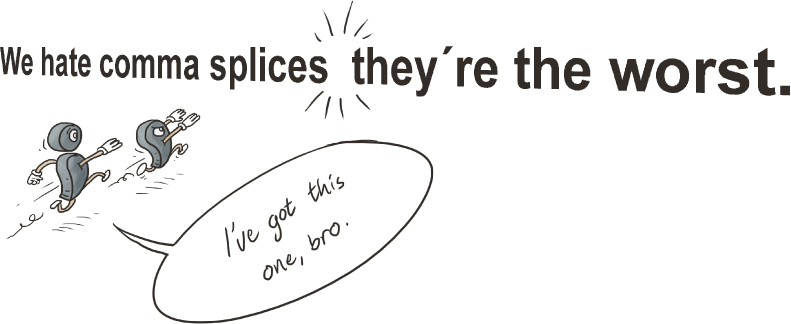What is a “comma splice,” anyway?
The word “splice” originates from the 1500s Renaissance period. Typically used as sailor’s term for rope lines, its explicit definition refers to the taking of two ropes, untangling them, and then weaving them back together. Its contemporary use however, associates with a common, and quite frankly, a hideous grammar issue known as the comma splice. In essence, a comma splice is the inappropriate joining of two independent clauses – two standalone phrases – using a comma. Some argue this is a punctuation error, and some argue that it is a type of run-on sentence. Depending on the instance, it could be both. When two independent clauses are together, the comma is not needed; a comma most often joins an independent clause with a dependent clause (a dependent clause cannot stand alone). Let us look at examples of the comma splice.

Source: Grammarly
Examples:
I love playing golf, I hate playing water polo. *INCORRECT USAGE*
I finished my book about the Recession of 2008 yesterday, it was boring. *INCORRECT*
My favorite musician is Jennifer Nettles, she is so talented and versatile. *INCORRECT*
Hardwood is my favorite choice of floors, I don’t like tile ones. *INCORRECT*
My cousin, a Stanford University student, lives in a dorm. *CORRECT*
In the case of the sentence with the improper use of the comma, both independent clauses each have a subject and a verb. However, as stated before, they are incorrectly put together with a comma. Although the comma splice is an easy issue to make and often goes under the radar, one can fix it easily.
How to fix it?
The first solution entails turning the two independent clauses into their own, separate sentences and concluding each one with a period. This might the easiest way to fix the comma splice and may be easier to read as the sentences are usually simple in form. Each individual, new formed sentence will contain a subject and a predicate. A corrected example from the set above might be: I love playing golf. I hate playing water polo.
The second solution requires the use of a coordinating conjunction combining the two clauses. The clauses should have what grammarians call “equal rank.” Although this is a subjective characteristic, it usually means the two clauses will be of similar importance and near the same type of construction. Also, an implied rule of “equal rank” is that the sentence should flow well style wise. Nonetheless, the comma splice can be solved by the use of a particular type of conjunction. Does the acronym “FANBOYS” ring a bell? It might include one of the following words: for, and, nor, but, or, yet, or so. Some proper examples would be: I finished my book about the Recession of 2008, and it was boring. Many think that drinking orange juice is good for your health, but we should not ignore its high glycemic index (sugar content).
A third alternative is similar to solution number one. It involves combining the two independent clauses with a semicolon. However, grammarians explain that the sentences should follow the “equal rank” doctrine, as explained above. Although it may appear obvious, the two independent clauses should talk about the same relative subject. Otherwise, the sentence would fail to flow. An example of using a semicolon to solve the comma splice would look like such: My favorite musician is Jennifer Nettles; she has so much talent and versatility. Our academic team’s division is competitive; we are up against schools like Meadow Lands, East View, Highland, and Deer Park.
Finally, a fourth solution may encompass removal of the comma and changing the clauses to dependent ones. This would also require implementation of a conjunction (a subordinating one), a transitional word, or another like phrase between them. Here is a correct example: Hardwood is my favorite choice of floors because I don’t like tile. Larry said he is picking me up from the clinic after I receive my flu shot and get tested for tuberculosis.
Implications
Usually, the presence of a comma splice signals informality, which can be detrimental in professional communication within a business setting. Oftentimes, the issue of the comma splice occurs when a writer or author wants to imply or project a continuation of a thought, but uses it incorrect. Inserting commas in your writing should create natural pauses (e.g., when forming a list, using an appositive phrase, transitional phrases). Also, placing one in the middle of the sentence and between two independent clauses, does not work. But, many are not aware that when using the comma splice, a problem exists. A scary thought for some is that it is growing in a negative way, particularly through quick electronic forms of communication, such as e-mail or text message. In an article from Business Insider, expert Grammarian, Bryan Garner said, “the comma splice was one of the most egregious errors he has seen gaining around in English.” Why? – it is careless and makes writing less academic and professional. Who is teaching this? In Garners eyes, it should be denounced.
Solutions
The following videos provide further explanations on solutions to the comma splice:
How to determine which of the solutions – (1) using a period, (2) using a coordinating conjunction, (3) using a semicolon, or (4) removing the comma – which is best? The article “The world’s top grammarian fears that this punctuation error is becoming standard English” by David McMahon. He notes that “’By reading aloud – is the single piece of writing advice – and choosing the version that best suits the context, your style, and your ear. Bryan Garner says, “If this methodology were applied (and respective offenders used it), then those using the comma splice *should* be able to both detect and correct their mistake(s)”.
Sometimes, the comma splice may be used either for both emphasis and stylistic reasons. These exceptions do not occur often, but can be found in, for instance, some literary settings (i.e., poetry, nonfiction). A popular example lies in the novel Pincher Martin by British author William Golding, where he writes, “The blue igloo-roof over the rock went away to a vast distance, the visible world expanded with a leap.” Besides the fact it does not meet standard English, comma-splicing is unappealing and creates an unnecessary gap between the two clauses. As stated before, this notion is true in both academic and business settings. The comma splice usually signals informality and can be the difference between a business deal made, earning a bid on the job, maintaining customer relations, and so on. This is why another name for the grammar error is called a “comma fault.” On numerous blogs, it is common to see the comma splice marked as terrible, disgraceful, and distasteful.

Source: Shmoop
Practice Questions
Now that you are well along in your understanding of the comma splice, this tutorial will progress to practice problems and enhance proficiency in correcting comma splice mistakes. For the following sentences, identify and correct the comma splice or mark “C” for “correct.” All of the sentences – correct or incorrect – will be business theme. Possible corresponding answers can be found below:
P1. Although he has much experience in business, President Trump does not understand the economy, it seems that he believes the sole indicator of its health is the stock market.
P2. My brother works in the financial trading of commodities, he is a stock broker.
P3. In the third quarter of 2018, General Motors announced that it will soon close many plants across the United States; this did not sit well with many manufacturing and industrial workers who would soon lose their jobs.
P4. The radio show “Marketplace,” hosted by Kai Ryssdal, is insightful, it discusses current issues in politics, finance, and economics.
P5. While many proponents expected the US-MCA to help, American dairy farmers are still struggling with low prices and surpluses of their products (particularly cheese), they require federal subsidies to stay afloat.
P6. The Marriott data breach uncovered poor internal controls/auditing, and CEO Arne Sorenson reflected on his company when he tried to defend their practices.
P7. Presidential hopeful and Sen. Amy Klobuchar (D-MN) explains that Facebook is a tech-giant and monopoly, she calls for it to be regulated appropriately.
P8. Recently, Apple revealed that it will increase its focus on service revenue, there are expectations it will release its own credit card, a television streaming service, and an aggregated newspaper database.
P9. It is not surprising that Boeing’s stock took a tumble after its announcements of flaws in their 737 models, which pose a constant threat to travelers abroad.
P10. By way of divorcing her husband, MacKenzie Bezos is now the fourth richest woman in the world, she will walk away with 25 percent of Jeff Bezos’ wealth, equivalent to about $36 billion dollars.
(Possible) Answers
- Although he has much experience in business, President Trump does not understand the economy. It seems he believes the sole indicator of its health is the stock market.
- My brother works in the financial trading of commodities because he is a stock broker.
- C
- The radio show “Marketplace,” hosted by Kai Ryssdal, is very insightful as it discusses current issues in politics, finance, and economics.
- While many proponents expected the US-MCA to help, American dairy farmers are still struggling with low prices and surpluses of their products (particularly cheese); they often require federal subsidies to stay afloat.
- C
- Presidential hopeful and Sen. Amy Klobuchar (D-MN) explains that Facebook is a tech-giant and monopoly and she calls for it to be regulated appropriately.
- Recently, Apple revealed that it will increase its focus on service revenue, and there are expectations it will release its own credit card, a television streaming service, and an aggregated newspaper database.
- C
- By way of divorcing her husband, MacKenzie Bezos is now the fourth richest woman in the world. She will walk away with 25 percent of Jeff Bezos’ wealth, equivalent to about $36 billion dollars.
Now you are on your way to using a comma more effectively. You’ll save yourself from embarrassment, too.


